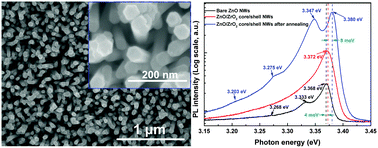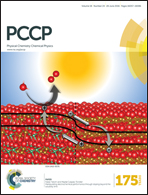Photoluminescence enhancement of ZnO nanowire arrays by atomic layer deposition of ZrO2 layers and thermal annealing
Abstract
The effects of shell thickness and rapid thermal annealing on photoluminescence properties of one-dimensional ZnO/ZrO2 core/shell nanowires (NWs) are studied in this work. The ZnO/ZrO2 core/shell structures were synthesized by coating thin ZrO2 layers on the surface of ZnO NWs using atomic layer deposition. The morphological and structural characterization studies reveal that the ZrO2 shells have a polycrystalline structure, which are uniformly and conformally coated on the high quality single-crystal ZnO NWs. As compared with bare ZnO NWs, the ZnO/ZrO2 core/shell structures show a remarkable and continuous enhancement of ultraviolet (UV) emission in intensity with increasing ZrO2 shell thickness up to 10 nm. The great improvement mechanism of the UV emission arises from the surface passivation and the efficient carrier confinement effect of the type-I core/shell system. Moreover, it is observed that the UV emission of ZnO/ZrO2 core/shell structures after thermal annealing increases with increasing annealing temperature. The dominant surface exciton (SX) emission in the bare ZnO NWs and the ZnO/ZrO2 core/shell nanostructures has been detected in the low temperature photoluminescence spectra. A blue shift of the NBE emission peak as well as the varied decay rate of the SX emission intensity are also found in the ZnO NWs after the growth of ZrO2 shells and further thermal treatment. Our results suggest that the ZnO/ZrO2 core/shell nanostructures could be widely implemented in the optical and electronic devices in the future.



 Please wait while we load your content...
Please wait while we load your content...